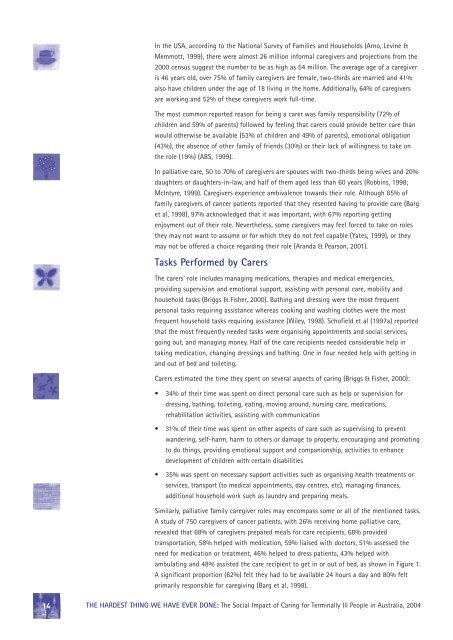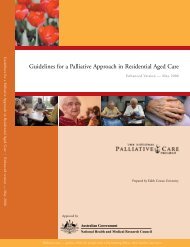The hardest thing we have ever done - Palliative Care Australia
The hardest thing we have ever done - Palliative Care Australia
The hardest thing we have ever done - Palliative Care Australia
Create successful ePaper yourself
Turn your PDF publications into a flip-book with our unique Google optimized e-Paper software.
In the USA, according to the National Survey of Families and Households (Arno, Levine &<br />
Memmott, 1999), there <strong>we</strong>re almost 26 million informal caregivers and projections from the<br />
2000 census suggest the number to be as high as 54 million. <strong>The</strong> average age of a caregiver<br />
is 46 years old, over 75% of family caregivers are female, two-thirds are married and 41%<br />
also <strong>have</strong> children under the age of 18 living in the home. Additionally, 64% of caregivers<br />
are working and 52% of these caregivers work full-time.<br />
<strong>The</strong> most common reported reason for being a carer was family responsibility (72% of<br />
children and 59% of parents) follo<strong>we</strong>d by feeling that carers could provide better care than<br />
would otherwise be available (53% of children and 49% of parents), emotional obligation<br />
(43%), the absence of other family of friends (30%) or their lack of willingness to take on<br />
the role (19%) (ABS, 1999).<br />
In palliative care, 50 to 70% of caregivers are spouses with two-thirds being wives and 20%<br />
daughters or daughters-in-law, and half of them aged less than 60 years (Robbins, 1998;<br />
McIntyre, 1999). <strong>Care</strong>givers experience ambivalence towards their role. Although 85% of<br />
family caregivers of cancer patients reported that they resented having to provide care (Barg<br />
et al, 1998), 97% acknowledged that it was important, with 67% reporting getting<br />
enjoyment out of their role. N<strong>ever</strong>theless, some caregivers may feel forced to take on roles<br />
they may not want to assume or for which they do not feel capable (Yates, 1999), or they<br />
may not be offered a choice regarding their role (Aranda & Pearson, 2001).<br />
Tasks Performed by <strong>Care</strong>rs<br />
<strong>The</strong> carers’ role includes managing medications, therapies and medical emergencies,<br />
providing supervision and emotional support, assisting with personal care, mobility and<br />
household tasks (Briggs & Fisher, 2000). Ba<strong>thing</strong> and dressing <strong>we</strong>re the most frequent<br />
personal tasks requiring assistance whereas cooking and washing clothes <strong>we</strong>re the most<br />
frequent household tasks requiring assistance (Wiley, 1998). Schofield et al (1997a) reported<br />
that the most frequently needed tasks <strong>we</strong>re organising appointments and social services,<br />
going out, and managing money. Half of the care recipients needed considerable help in<br />
taking medication, changing dressings and ba<strong>thing</strong>. One in four needed help with getting in<br />
and out of bed and toileting.<br />
<strong>Care</strong>rs estimated the time they spent on s<strong>ever</strong>al aspects of caring (Briggs & Fisher, 2000):<br />
• 34% of their time was spent on direct personal care such as help or supervision for<br />
dressing, ba<strong>thing</strong>, toileting, eating, moving around, nursing care, medications,<br />
rehabilitation activities, assisting with communication<br />
• 31% of their time was spent on other aspects of care such as supervising to prevent<br />
wandering, self-harm, harm to others or damage to property, encouraging and promoting<br />
to do <strong>thing</strong>s, providing emotional support and companionship, activities to enhance<br />
development of children with certain disabilities<br />
• 35% was spent on necessary support activities such as organising health treatments or<br />
services, transport (to medical appointments, day centres, etc), managing finances,<br />
additional household work such as laundry and preparing meals.<br />
Similarly, palliative family caregiver roles may encompass some or all of the mentioned tasks.<br />
A study of 750 caregivers of cancer patients, with 26% receiving home palliative care,<br />
revealed that 68% of caregivers prepared meals for care recipients, 68% provided<br />
transportation, 58% helped with medication, 59% liaised with doctors, 51% assessed the<br />
need for medication or treatment, 46% helped to dress patients, 43% helped with<br />
ambulating and 48% assisted the care recipient to get in or out of bed, as shown in Figure 1.<br />
A significant proportion (62%) felt they had to be available 24 hours a day and 80% felt<br />
primarily responsible for caregiving (Barg et al, 1998).<br />
14 THE HARDEST THING WE HAVE EVER DONE: <strong>The</strong> Social Impact of Caring for Terminally Ill People in <strong>Australia</strong>, 2004
















